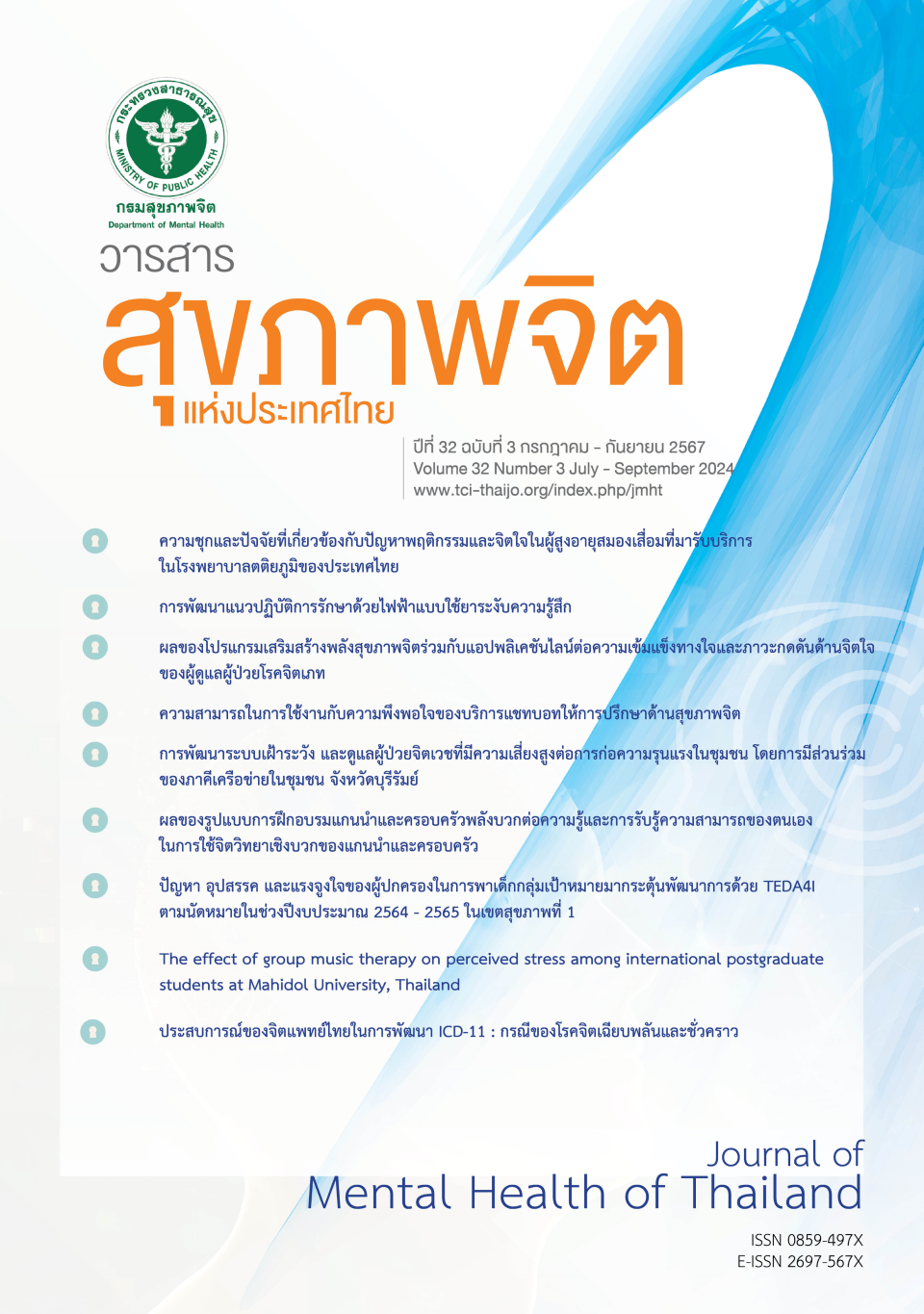ประสบการณ์ของจิตแพทย์ไทยในการพัฒนา ICD-11 : กรณีของโรคจิตเฉียบพลันและชั่วคราว
คำสำคัญ:
จิตแพทย์ไทย, ประสบการณ์, โรคจิตเฉียบพลันและชั่วคราว, องค์การอนามัยโลก, ICD-11บทคัดย่อ
วัตถุประสงค์ : เพื่อถ่ายทอดประสบการณ์ที่ผู้นิพนธ์ได้มีส่วนร่วมในการพัฒนาบัญชีจำแนกทางสถิติระหว่างประเทศของโรค (international classification of diseases: ICD) ฉบับที่ 11 (ICD-11) ในการจำแนกกลุ่มโรคจิต โดยเฉพาะโรคจิตเฉียบพลันและชั่วคราว รวมทั้งเพื่อนำเสนอการเปลี่ยนแปลงที่สำคัญจากฉบับก่อนหน้า
วิธีการ : รวบรวมเอกสารที่เกี่ยวข้องกับ ICD-10, ICD-11 และโรคจิตเฉียบพลันและชั่วคราว โดยสืบค้นจากฐานข้อมูล Pubmed, ThaiJO, และสื่อสิ่งพิมพ์จากเว็บไซต์ รวมทั้งจากประสบการณ์ตรงของผู้นิพนธ์
ผล : เดิม ICD ได้มีการทบทวนเป็นระยะโดยองค์การอนามัยโลก ครั้งสุดท้ายเป็นการทบทวนครั้งที่ 10 (ICD-10) ที่เผยแพร่เมื่อปี พ.ศ. 2535 ต่อมาในปี พ.ศ. 2549 องค์การอนามัยโลกได้ทบทวน ICD-10 และเริ่มพัฒนา ICD-11 โดยแต่งตั้งคณะกรรมการที่ปรึกษานานาชาติและคณะทำงานในการจำแนกกลุ่มโรคต่าง ๆ ซึ่งผู้นิพนธ์อยู่ในคณะทำงานกลุ่มโรคจิต และถูกมอบหมายให้รับผิดชอบเรื่องโรคจิตเฉียบพลันและชั่วคราว จึงได้ทบทวนงานวิจัยของโรคนี้และจัดทำข้อเสนอแนะขึ้น องค์การอนามัยโลกได้รวบรวมข้อเสนอแนะของคณะทำงานทุกกลุ่มโรคแล้วจัดทำเป็น ICD-11 ฉบับร่างเพื่อรับฟังความคิดเห็นและนำไปปรับปรุง ต่อมามีการทดสอบภาคสนามและการทดสอบในผู้ป่วยจริงเพื่อเปรียบเทียบคุณประโยชน์ระหว่าง ICD-11 กับ ICD-10 ในการวินิจฉัยโรค สำหรับโรคจิตเฉียบพลันและชั่วคราวใน ICD-11 ได้มีการปรับปรุงให้วินิจฉัยได้ง่ายขึ้น โดยยกเลิกการแบ่งเป็นชนิดต่าง ๆ ของ ICD-10 แต่แบ่งโรคตามมิติจำนวนครั้งของการป่วยและระยะของโรคขณะประเมินว่ายังมีอาการอยู่มากน้อยเพียงใดหรืออยู่ในภาวะโรคสงบแล้ว
สรุป : การวินิจฉัยโรคทางจิตเวชเป็นพลวัต ซึ่งเกณฑ์การวินิจฉัยโรคสามารถปรับเปลี่ยนได้ตามหลักฐานทางวิชาการในปัจจุบัน จิตแพทย์และบุคลากรสุขภาพจิตไทยควรศึกษาวิจัยเพิ่มเติมในหลากหลายประเด็นเกี่ยวกับโรคจิตเฉียบพลันและชั่วคราวเพื่อประโยชน์ในการพัฒนา ICD ครั้งต่อไป
Downloads
เอกสารอ้างอิง
World Health Organization. The ICD-10 classification of mental and behavioural disorders: Clinical descriptions and diagnostic guidelines. Geneva: World Health Organization; 1992.
International Advisory Group for the Revision of ICD-10 Mental and Behavioural Disorders. A conceptual framework for the revision of the ICD-10 classification of mental and behavioural disorders. World Psychiatry. 2011;10(2):86-92. doi:10.1002/j.2051-5545.2011.tb00022.x.
Gaebel W, Reed GM. Status of psychotic disorders in ICD-11. Schizophr Bull. 2012;38(5):895-8. doi:10.1093/schbul/sbs104.
World Health Organization. The ICD-11 chapter on mental, behavioural and neurodevelopment disorders: clinical descriptions and diagnostic requirements. Geneva: World Health Organization. 2024. [cited 2024 June 15] Available from: https://iris.who.int/bitstream/handle/10665/375767/9789240077263-eng.pdf?sequence=1
Udomratn P. ICD-10-TM: How the section on mental disorders should be modified? J Psychiatr Assoc Thailand. 2000:45:383-91. (in Thai)
Udomratn P. How Thailand has modified the section on mental disorders in the international statistical classification of diseases and related health problems 10th revision (ICD-10). Asia Pac Psychiatry. 2009;1(2):88-9. doi:10.1111/j.1758-5872.2009.00022.x.
Blom RM, Hennekam RC, Denys D. Body integrity identity disorder. PLoS One. 2012;7(4):e34702. doi:10.1371/journal.pone.0034702.
American Psychiatric Association. Diagnostic and statistical manual of mental disorders. 5th ed. (DSM-5). Washington DC: American Psychiatric Publishing; 2013.
Reed GM. Development and innovation in the ICD-11 chapter on mental, behavioural and neurodevelopment disorders. In: Tyrer P, editor. Making sense of the ICD-11 for mental health professionals. Cambridge: Cambridge University Press, 2023. p. 5-16.
Reed GM, Sharan P, Rebello TJ, Keeley JW, Medina-Mora ME, Guraje O, et al. The ICD-11 developmental field study of reliability of diagnosis of high-burden mental disorders: results among adult patients in mental health settings of 13 countries. World Psychiatry. 2018;17(3):174-86. doi:10.1002/wps.20524.
Reed GM, Keeley JW, Rebello TJ, First MB, Guraje O, Ayuso-Mateos JL, et al. Clinical utility of ICD-11 diagnostic guidelines for high-burden mental disorders: results from mental health settings in 13 countries. World Psychiatry. 2018;17(3):306-15. doi:10.1002/wps.20581.
Udomratn P. Nonorganic psychotic disorders. In: Tantiphlachiva K, Otrakul A, Limsuwan N, Suampun A, editors. Textbook of psychiatry. 2nd ed. Bangkok: The Psychiatric Association of Thailand; 1993. p 445-57. (in Thai)
Udomratn P, Burns J, Farooq S. Acute and transient psychotic disorders: an overview of studies in Asia. Int Rev Psychiatry. 2012;24(5):463-6. doi:10.3109/09540261.2012.
Lopez-Diaz A, Fernandez-Gonzales J, Lara I, Ruiz-Veguilla M. Predictors of diagnostic stability in acute and transient psychotic disorders: validation of previous findings and implications for ICD-11. Eur Arch Psychiatry Clin Neurosci. 2019;270:291-9. doi:10.1007/s00406-019-01014-z.
Gozi A. Highlights of ICD-11 classification of mental, behavioural, and neurodevelopmental disorders. Ind J Priv Psychiatry. 2019;13(1):11-7. doi:10.5005/jp-journals-10067-0030.
ดาวน์โหลด
เผยแพร่แล้ว
รูปแบบการอ้างอิง
ฉบับ
ประเภทบทความ
สัญญาอนุญาต
ลิขสิทธิ์ (c) 2024 วารสารสุขภาพจิตแห่งประเทศไทย

อนุญาตภายใต้เงื่อนไข Creative Commons Attribution-NonCommercial-NoDerivatives 4.0 International License.
- ผู้อ่านสามารถนำข้อความ ข้อมูล จากวารสารไปใช้ไปใช้ประโยชน์ทางวิชาการได้ เช่น เพื่อการสอน เพื่อการอ้างอิง แต่การนำไปใช้เพื่อวัตถุประสงค์อื่น เช่น เพื่อการค้า จะต้องได้รับอนุญาตเป็นลายลักษณ์อักษรจากกรมสุขภาพจิตก่อน
- ความคิดเห็น ข้อมูล และบทสรุปต่าง ๆ ที่ลงตีพิมพ์ในวารสารสุขภาพจิตแห่งประเทศไทยเป็นของผู้เขียนบทความและมิได้แสดงว่ากองบรรณาธิการหรือกรมสุขภาพจิตเห็นพ้องด้วย




